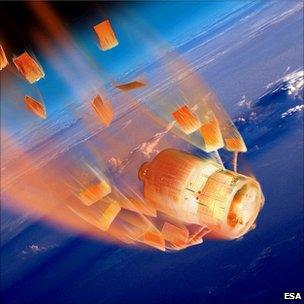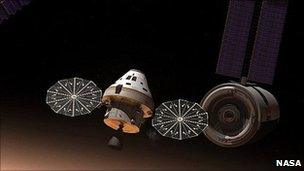Europe's ATV space freighter burns up
- Published

Artist's impression: Contact with Kepler was lost at 2041:39 GMT at an altitude of 80km
Europe's space freighter has destroyed itself over the South Pacific.
TheATV-Johannes Kepler, externalship took 1.3 tonnes of rubbish from the space station into a controlled dive into the atmosphere just before 2100 GMT on Tuesday.
Most of the vehicle and its waste cargo would have been vaporised in the descent.
Only a few robust pieces of hardware could have survived to the ocean surface, say officials.
The burn-up brings to an end Kepler's four-month mission to the station.
Its purpose had been to deliver more than seven tonnes of fuel, food, air and equipment to the orbiting platform.
Kepler also used its big thrusters to push the International Space Station (ISS) higher into the sky.
The space lab is now flying at an altitude of more than 380km (235 miles) - its furthest ever distance from Earth in its finished configuration.
It means the station will now experience less drag from the wisps of air still present high above the planet that work to pull the platform downwards over time.
The European Space Agency (Esa) has been delighted by the robotic ship's performance since its launch in February.
Its automatic rendezvous and docking systems had no problem finding the ISS; and then, having attached itself to the back of platform, the truck operated in a flawless fashion.
Kepler was the second such freighter flown by Esa; the first, known as Jules Verne, completed its mission to the station in 2008.
The Automated Transfer Vehicles (ATV is their generic name) are the means by which Europe pays its share of the common operating costs of the platform project. It is a barter arrangement in which capability and hardware is provided instead of cash.

Nasa's MPCV would take astronauts beyond the ISS into deeper space
Three further freighters are planned, with the first of these - Edoardo Amaldi - due to launch at the end of February next year. The final two will go up in 2013 and 2014.
Beyond them, Esa is looking to take the capabilities and expertise gained on the trucks into a new type of spacecraft - something it has dubbed for the moment simply as the "ATV Derivative".
Its purpose and design are currently being discussed with the US space agency, Nasa.
One possible outcome is some sort of European contribution to the Americans' Multi-Purpose Crew Vehicle (MPCV).
The MPCV is envisaged by Nasa as a manned ship that could take astronauts beyond the space station, to the Moon, asteroids and Mars.
Ideas are far from fully formed, but an ATV-like tug could help assemble in orbit the elements of an expedition that started out from the station. Perhaps the derivative could even provide some propulsive capability to send the MPCV on its way.
Speaking at this week's Paris Air Show, Esa officials said they would report progress on the talks to the agency's member states in October.
"I don't want to beat about the bush - I think it would be fantastic if there would be a mission going beyond low-Earth orbit for this barter. But once again we need to understand the technical details," said Thomas Reiter, the former German astronaut now in charge of Esa's human spaceflight programme.
"It's not in so much detail that I can tell you much about it, other than we've had two interface discussions," he told BBC News.
Esa director general Jean-Jacques Dordain also emphasised the preliminary nature of the dialogue. In addition, he underlined the need for the ATV Derivative to fulfil roles that matched Europe's interests and objectives away from the MPCV. In this context, the derivative could be a robotic vehicle to carry out the in-orbit servicing of other spacecraft.
"We should converge towards the autumn of this year, possibly not on one single vehicle but at least on one module, that would make it possible to have some derivatives in the future, with perhaps one vehicle provided to the US and one that we could use in other circumstances," Mr Dordain told BBC News.
- Published19 June 2011
- Published5 May 2011
- Published25 May 2011
- Published2 March 2011
- Published24 February 2011
- Published17 February 2011